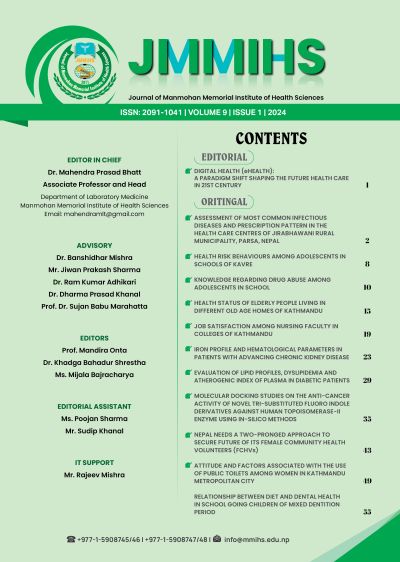Assessment of Most Common Infectious Diseases and Prescription Pattern in The Health Care Centres of Jirabhawani Rural Municipality, Parsa, Nepal
DOI:
https://doi.org/10.3126/jmmihs.v9i1.68625Keywords:
Infectious diseases, Drug prescribing pattern, WHO indicator, AntimicrobialAbstract
Background: The term “infectious disease” refers to a group of diseases that are contagious or transmissible caused by pathogenic biological agents such as bacteria, viruses, fungi, parasites, and protozoa in a single host organism. This study was conducted to know about most common infectious diseases and prescription pattern in three health posts of Jirabhwani, Rural Municipality Parsa, Nepal.
Method: Descriptive Cross-sectional study was conducted by analyzing 331 prescriptions of patients suffering from different infections disease using data collection form recommended by WHO that includes the patient and drug related data as well as other information.
Results: The most infectious diseases was Scabies (24.74%) followed by chronic wound (12.20%) and fungal infections (10.80%). Majority of cases were in between the age group of 11-21 years (19.64%). The average number of drugs per prescription was 2.06. Out of 683 drugs prescribed, antimicrobials (42.90%) were most commonly prescribed among which most commonly prescribed was Amoxycillin (30.59%) followed by Gamma Benzene Hexachloride (19.12%). Similarly, 24.16% antihistamines and 22.84% NSAIDS were prescribed among which Paracetamol (75.5%) was most commonly prescribed. The drugs prescribed by generic name was 73.3% according to WHO indicators.
Conclusion: The most common infections found was scabies followed by chronic wound and frequently prescribed antibiotic was amoxicillin.
Downloads
Downloads
Published
How to Cite
Issue
Section
License
© Journal of Manmohan Memorial Institute of Health Sciences (JMMIHS)
All rights reserved to JMMIHS. Any part of this journal cannot be reproduced, or transmitted in any form including electronic mail, photocopying or recording or otherwise without prior written permission of the publisher.




